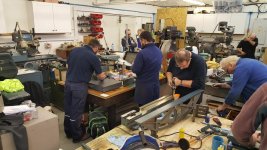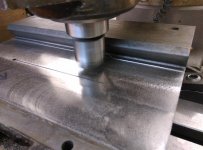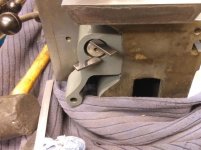Peter.
Titanium
- Joined
- Mar 28, 2007
- Location
- England UK
I've been scraping turcite today on the underside of my HLV saddle. Learned a few things and found a new trick so I thought I'd show it here.
I had already glued this Turcite on at last year's scraping class (a year that has literally flown by) so I was ready to go. Here's the jig all clamped up last year after fixing the sheet to the saddle:


I just needed to get a good reference to make sure that I scraped the turcite not only flat but on the correct plane, with me not knowing how flat and even the stuff was glued down. At first I tried using a surface gauge and indicator working of the high ledge in the picture above but I found that this surface wasn't ground and wasn't flat. Looked like it had been planed and left as-is. Anyway, the surface gauge rocked about a bit on it so I forgot about it.
The front surface with the holes in it however was ground - has to be because it locates the apron and with it the front veeway gib so it absolutely has to be co-planar to the flat way.
I knocked up three small jacks about an inch tall. turned a shallow peak on the bolt heads leaving a small flat to stand stuff on.

I stood the saddle up-turned on those jacks and adjusted them until the ground flat face was parallel to the surface plate. I have a large comparator stand Which is rock-solid, and I used this with a tenth indicator. to sweep the shiny face length-ways and across.

After that I mapped the face of the turcite in 1-inch squares using the DTI. Found that it was all over the place the biggest variation being 6 thou. Wasn't expecting that I have to say but nothing to do but scrape it down flat. The pic above is where I got to before packing up for the day. Got to get rid of that last little dip at the end tomorrow then bring in the bearing points.
I had already glued this Turcite on at last year's scraping class (a year that has literally flown by) so I was ready to go. Here's the jig all clamped up last year after fixing the sheet to the saddle:


I just needed to get a good reference to make sure that I scraped the turcite not only flat but on the correct plane, with me not knowing how flat and even the stuff was glued down. At first I tried using a surface gauge and indicator working of the high ledge in the picture above but I found that this surface wasn't ground and wasn't flat. Looked like it had been planed and left as-is. Anyway, the surface gauge rocked about a bit on it so I forgot about it.
The front surface with the holes in it however was ground - has to be because it locates the apron and with it the front veeway gib so it absolutely has to be co-planar to the flat way.
I knocked up three small jacks about an inch tall. turned a shallow peak on the bolt heads leaving a small flat to stand stuff on.

I stood the saddle up-turned on those jacks and adjusted them until the ground flat face was parallel to the surface plate. I have a large comparator stand Which is rock-solid, and I used this with a tenth indicator. to sweep the shiny face length-ways and across.

After that I mapped the face of the turcite in 1-inch squares using the DTI. Found that it was all over the place the biggest variation being 6 thou. Wasn't expecting that I have to say but nothing to do but scrape it down flat. The pic above is where I got to before packing up for the day. Got to get rid of that last little dip at the end tomorrow then bring in the bearing points.















